
Manufacturer's Specifications:
Nakamichi Tonearm
Type: Straight balanced, viscous-damped.
Total Arm Length: 12 in. (305 mm).
Effective Arm Length: 9.3 in. (237 mm).
Effective Arm Mass: 14 grams (without cartridge).
Tracking Force Adjustment Range: 0 to 3 grams.
Allowable Cartridge Weight: 4 to 11 grams.
Cartridge Offset Angle: 21.5°.
Stylus Overhang: 0.59 in.-(15 mm).
Maximum Tracking Error: + 2.5° to-1°.
Price: $1,740, included with Dragon-CT turntable.
Company Address: 19701 South Vermont Ave., Torrance, Cal. 90502.
Shure Cartridge
Channel Balance: Within 1.5 dB.
Channel Separation: 25 dB or greater at 1 kHz, 18 dB or greater at 10 kHz.
Tracking Force, at Stylus Tip: Optimum, 10 mN (1.0 gram); maximum, 12.5 mN (1.25 grams).
Tracking Force, Total Tonearm Setting with Dynamic Stabilizer: Optimum, 15 mN (1.5 grams); maximum, 17.5 mN (1.75 grams).
Tip Geometry: Micro-Ridge, 3.8 x 76 microns (0.15 x 3 mils), long contact area.
Trackability at 10 mN (1 Gram)
Tracking Force: At 400 Hz, 30 cm/S; at 1 kHz, 46 cm/S; at 5 kHz, 80 cm/S; at 10 kHz, 60 cm/S; all figures typical in cm/S peak velocity.
Vertical Tonearm Resonance: Less than 5-dB rise at 14 Hz in SME Series III arm (without SME damper).
Output Voltage: 3.2 mV rms at 1 kHz at 5 cm/S peak velocity, typical.
Frequency Response: 10 Hz to 28 kHz.
Recommended Load: 47 kilohms in parallel with 250 pF (including tonearm wiring, connecting cables, and pre amplifier input).
Capacitive loading from 100 to 400 pF will cause negligible change from the recommended 250-pF loading.
Resistance: 815 ohms, typical.
Inductance: 330 mH at 1 kHz, typical.
Weight: 6.6 grams.
Price: $275; replacement stylus, $125.
Company Address: 222 Hartrey Ave., Evanston, Ill. 60204.
In the preceding review, I have discussed the Nakamichi Dragon-CT turntable and its innovative Absolute Center Search feature. This system assures that the record rotates with perfect concentricity, thus eliminating the effects of laterally induced wow. The Dragon-CT turntable comes with an integral tonearm which, without fanfare, proved to be of very high quality. I installed a Shure V15 Type V-MR cartridge and this perhaps unlikely combination produced remarkable performance. Shure has steadily improved its V15 series of cartridges, and the V-MR offers a level of performance which is truly outstanding. The company has been consistent in its progress, in the sense that they have gained a reputation for producing better and better products, over the years, without sacrificing reliability.
I learned a great deal about the synergy between a cartridge and a tonearm while investigating this combination. Bear in mind that I am not saying that the Shure V15 Type V-MR should only be used with the Dragon-CT tone-arm or vice versa, but I do believe that the characteristics of each should be a guide to finding other compatible tonearm/cartridge combinations.
I must admit that I didn't think the Dragon-CT tonearm and V15 Type V-MR cartridge would produce the level of sound quality that it did, in fact, achieve. The appearance of the Dragon-CT tonearm, to me, is very businesslike. And Nakamichi, in its promotional material, plays up the features of the turntable while, by relative lack of emphasis, implying that the tonearm is little more than a worthy partner to an exceptional turntable. For its part, Shure has never played to the "cartridge of the month" crowd, and I sometimes wonder if they are also victims of the "a prophet is without honor in his own country" syndrome. I am probably as guilty as anyone in this regard.
My first visual impression about the Nakamichi tonearm was the fact that the mechanism for coupling the headshell was placed at the back of the arm tube, near the main pivots of the tonearm. This is a smart move for a number of reasons. Placing the mass of the coupling away from the end of the arm reduces the effective mass; also, the joint between the headshell and the arm tube can be made solid, reducing the tendency for short-wavelength, high-amplitude, reflected energy while retaining the advantage of easily interchangeable cartridges.
The Shure V15 V-MR cartridge was easier to mount than most cartridges. In addition to the usual hex nuts, they supply threaded inserts that slip into lips on each side of the cartridge body. After the proper shim, also provided by Shure, is put in place, the cartridge is fastened securely to the headshell/arm tube. The shim is necessary because the tonearm height is fixed; the height of the cartridge and shim must be combined to place the cartridge in the correct position relative to the record surface.
My first really interesting impressions came when I began to listen to music. I had not expected such openness and clarity; I am rather jaded about this, too, as I have been fortunate because I have heard some really great sound reproduction over the years. The listening panel was really put to the test this time, because the level of performance was excellent and so closely resembled that of the reference system. Discerning differences was very difficult.
The base of the Dragon-CT tonearm is mounted directly to the turntable, with no way to adjust for cartridges of different body heights. As I mentioned before, shims are supplied by Shure for this purpose. It appears that Nakamichi has allowed for any known cartridge and then added a little extra height just to be safe, so I imagine that every cartridge will require the use of some shimming. There are those who claim the best way to mount a cartridge to a headshell is directly and tightly. I tend to agree with their rationale, which is to provide a continuous path from the cartridge to the arm pivots for any mechanical energy. If there is a weak point in the Nakamichi/Shure combination it is here, where they meet. This will be looked at later in the technical measurements for the pair.
The tracking force is adjusted by turning a counterweight at the rear of the tonearm. The arm is first balanced with this counterweight, and then a calibration ring is set to zero. Turning the counterweight to move it toward the main pivot sets the tracking force. I found the calibration to be excellent when I checked it with a separate precision gauge. It was off by less than 0.1 gram from 0.5 to 2.0 grams. The counterweight is viscous-damped by silicone fluid and has a very snug feel about it. It is set very close to the main pivots when a 6- to 7-gram cartridge is balanced, which is the best position to reduce effective dynamic mass. Side-thrust compensation is provided by a calibrated knob at the side of the main pillar. The main pivot bearings are excellent, exhibiting very low friction and no discernible play.
The V15 Type V-MR has a newly developed stylus tip design called Micro-Ridge, which is closer to the shape of a disc-cutting stylus than any stylus Shure has ever made.The tip is highly polished by a method Shure calls MASAR-polishing, which tends to reduce record wear and distortion.
The beryllium cantilever is formed into a thin-walled tube which is very light and strong. The specified inductance of the fixed magnetic coils is 330 mH; this, coupled with the coil resistance of about 815 ohms, results in a moderate value of generator impedance. The V15 Type V-MR was affected very little by variations in load resistance and capacitance because of this. Normally, a change in coil design to achieve lower impedance would result in reduced electrical output from the cartridge. Shure has compensated for this change in coil design by using a high-efficiency magnet structure. The internal parts are encapsulated to hold them rigidly in place to avoid resonances.
A viscous-damped Dynamic Stabilizer is another integral part of the V15 V-MR. It includes a brush with conductive fibers that not only clean the grooves but dissipate the static charge which builds up on the record and affects tracking force.
Years ago, when other manufacturers were racing to claim the highest value of compliance for their cartridges, Shure came to the rescue of the industry by introducing the concept of trackability. Each manufacturer was increasing the low-frequency tracking capability of their cartridges by increasing the amount of compliance, but the trade-off was high-frequency distortion. Later on, Shure enhanced the trackability concept by including the whole range of recorded signals; they called this the Trackability Factor (TF). Shure's latest concept appears to be another rescue mission. At a time when adopting the shape of the original disc-cutting stylus seems to be the goal of other stylus manufacturers, the Shure Total Trackability Index (TTI) takes into account the effect of the stylus tip and tracking force upon wear of both the tip and records. The ability of a cartridge shape to track heavily modulated, high-frequency record grooves, and therefore claim a high TF, is balanced by looking at its Indentation Factor (IF), which relates to the combination of stylus geometry and tracking force. The more the stylus tip indents the groove wall, the harder it is on the record. Arbitrarily, the spherical tip was chosen as the reference and given an IF of 1.00; the V15 V-MR has an IF of about 0.9 at 1.5 grams. A cartridge with a high TF and a low IF thus attains a high TTI because of its optimum trade-off of design qualities. The V15 V-MR's TTI rating is 104.1, the best of any cartridge in the Shure line to date.
Measurements and Listening Tests
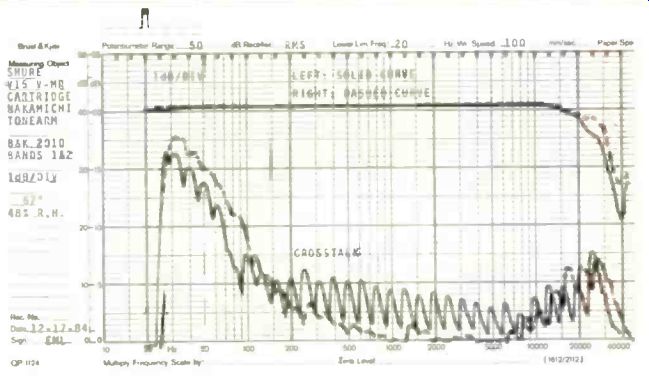
Fig. 1--Frequency response and crosstalk, Shure V15 Type V-MR cartridge in
Nakamichi Dragon-CT tonearm.
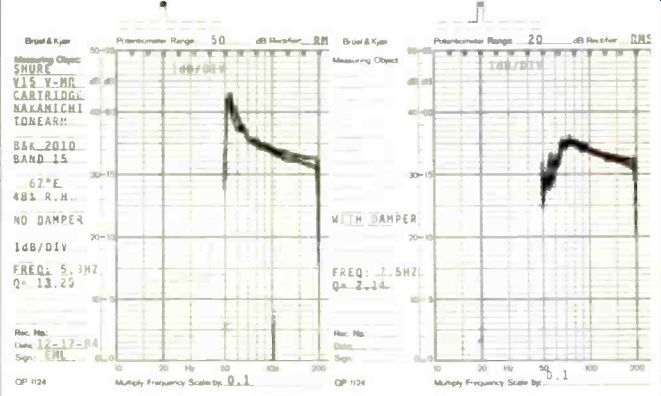
Fig. 2--Low-frequency tonearm/cartridge resonance is at 5.3 Hz with a I of
13.25 without the cartridge's damping brush. With the damping brush, resonance
is at 7.5 Hz and Q is 2.14.
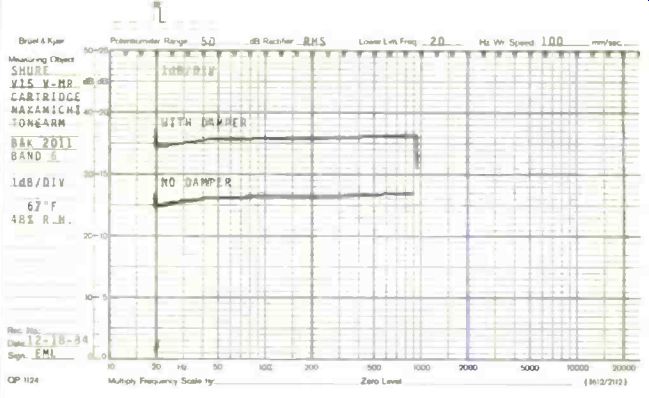
Fig. 3-Slow sweep from 20 Hz to 1 kHz to check for resonances in Dragon-CT
tonearm.
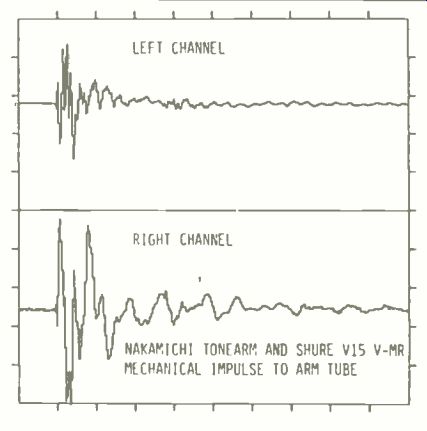
Fig. 4--Output of tonearm/cartridge to mechanical impulse applied to arm tube,
with tonearm on arm rest. Left channel shows more high-frequency output; right
channel shows more lows.
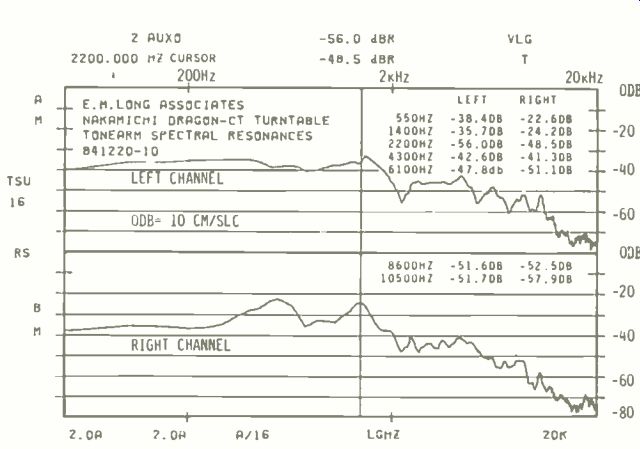
Fig. 5-Spectral output of Nakamichi tonearm due to mechanical impulses applied
to the arm tube (16 impulses have been averaged). Most of the energy appears
in the middle register, which could add to perceived brightness.
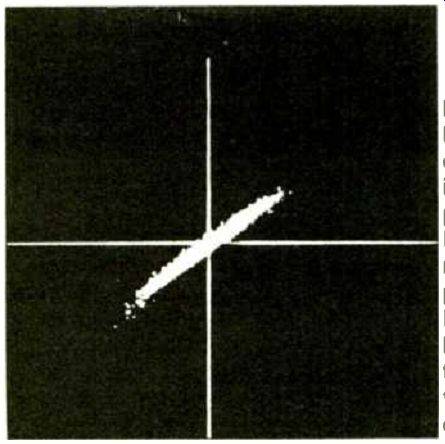
Fig. 6--Left vs. right channel interchannel phase using B & K 2011 test
record, band 7, pink noise. Response is the best ever seen by the author for
any tonearm/cartridge combination.
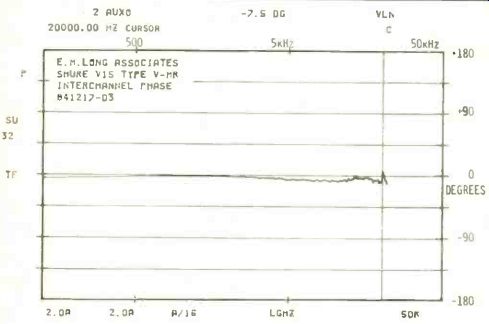
Fig. 7--Interchannel phase using B & K 2011, band 7, pink noise. Phase
difference at 20 kHz is -7.5° (1.0 µS).
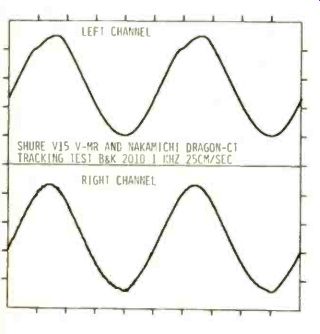
Fig. 8--Output of the tonearm/cartridge with band 3 of the B & K 2010
test disc, where slight mistracking occurred. This is the highest level on
the disc and is remarkable performance.

Fig. 9--Spectrum of output shown in Fig. 8, band 3 of the B & K 2010.
Most cartridges cannot track this band, a 1-kHz tone at 25 cm/S. Cursor is
at third harmonic and level is 2.8% left and 2.0% right. (Measurements taken
without Shure cartridge's damping brush.)
Figure 1 shows the left- and right-channel frequency response and crosstalk for the Shure V15 Type V-MR cartridge in the Nakamichi Dragon-CT tonearm. The low-frequency crosstalk is mainly caused by the B & K 2010 test record, which I use because it has a lower amount of middle-register crosstalk than other test records. The response of this record extends to 45 kHz, albeit with some inherent roll-off. The graph shows almost ruler-flat response to 15 kHz, and part of the roll-off above this point is due to the test record. Another factor is the relatively high capacitance (137 pF) of the phono cable supplied by Nakamichi.
The difference between channels is well within Shure's 1.5-dB specification. I also checked the effect of different values of capacitance and found that a total load capacity of 230 pF caused a little flatter output to 30 kHz. Changing the load resistance to 100 kilohms had little effect.
One reason that I thought the V15 V-MR cartridge might be a good match for the Dragon-CT tonearm was the reasonably low internal capacitance of its wiring, which I measured to be 50 pF. This level would not adversely affect either low-impedance MC or moderate-impedance MM cartridges. The other reason was the high internal lead resistance, which would affect the output of low-impedance MC cartridges, but not the moderate impedance of the V15 V-MR. I would have expected Nakamichi would design the Dragon-CT tonearm to be used with low-impedance MC cartridges, but this rather high internal lead resistance means that only the newer, moderate-impedance, high-output types should be used.
Figure 2 shows the low-frequency resonance caused by the combination of the cartridge's compliance and the tone-arm's effective mass. The Q without any damping is a high 13.25; the resonant frequency is 5.3 Hz, which can make it very susceptible to vertically induced warp wow. Although the tonearm has a viscous damping system near the pivots, chose to use the cartridge's Dynamic Stabilizer damper-brush system because it is located near the stylus-where it is more .effective in reducing warp-induced problems. As you can see, it not only reduced the Q to a very acceptable 2.14, but it raised the resonant frequency slightly, to 7.5 Hz.
When I played an old recording of Gershwin's "Concerto in F" and "Rhapsody in Blue" by the Eastman Rochester Orchestra, which has very high modulation and some vertical warp, it sounded magnificent, without a hint of trouble. (I was there when this recording was being made by Bob Fine for Mercury, and I first met Bert Whyte and his wife in the garage next to the Eastman Theater where Bob had parked his recording truck. Rochester, N.Y. is my hometown, and, being young and daring, I just walked in and proceeded to watch and learn.) Further, the comments made by the listening panel about the piano sound on other recordings were all very positive, and they had great difficulty in finding any difference between the Nakamichi/Shure combination and the reference system.
Figure 3 shows the results of a slow sweep, from 20 Hz to 1 kHz, which is intended to excite any resonance in the tonearm/cartridge combination. Very small effects can be seen at 40 and 80 Hz which might be due to the coupling near the pivot; this is reduced slightly by using the damper brush. The other effect, at 550 Hz, is a tonearm resonance which is verified by the results of the mechanical impulse test (Figs. 4 and 5). When the damper brush is used, the resonance is reduced and moves to 410 Hz. This resonance might be one reason for the comments made by some panel members about the "more resonant" quality of male voices heard on the Dragon-CT as against the reference.
Figures 4 and 5 show the output of the tonearm/cartridge combination for a mechanical-impulse test I devised to check for resonances. The difference in the channels is due to the method and angle of application of the impulse, which excites each channel differently. (I am refining this test to eliminate this difference; in the meantime, I think the results are still worth showing.) In Fig. 5, the resonance at 550 Hz is clearly visible; other resonances are listed along with their relative levels. The absolute levels don't mean anything because, although referenced to a 0-dB level of 10 cm/S, they are caused by a mechanical impulse of arbitrary value.
What is worth noting are the resonant frequencies and their relative levels.
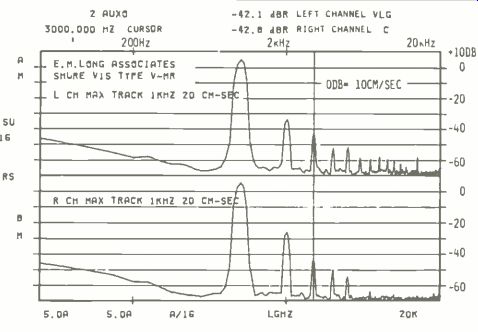
Fig. 10--Spectrum due to 1-kHz tone at 20 cm/S, band 4 of B & K 2010 test
disc. Although most cartridges have difficulty tracking this band, the Shure/Nakamichi
combination tracked it easily. Cursor is at third harmonic and level is 0.40%
left and 0.37% right. (Measurements taken without damper.)
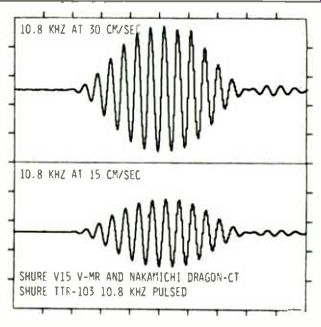
Fig. 11--Tests of 10.8-kHz tone burst from Shure TTR-103 test record, bands
1 and 4. Any mistracking results in low-frequency output which will color the
sound.
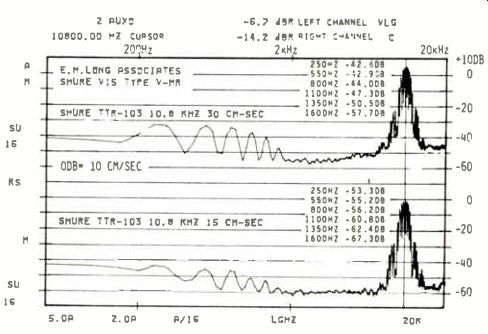
Fig. 12--Spectrum of distortion for 10.8-kHz tone burst of Fig. 11. Top: 30
cm/S, which is +8 dB above reference level of 10 cm/S. Bottom: 15 cm/S. The
250-Hz output is about 0.3%, which is very good. See text.
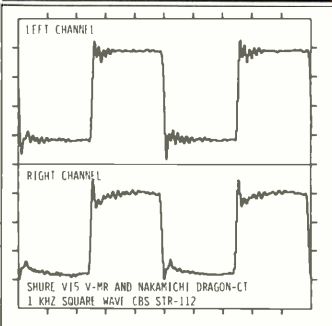
Fig. 13--Response to a 1-kHz square wave.
----MEASURED DATA
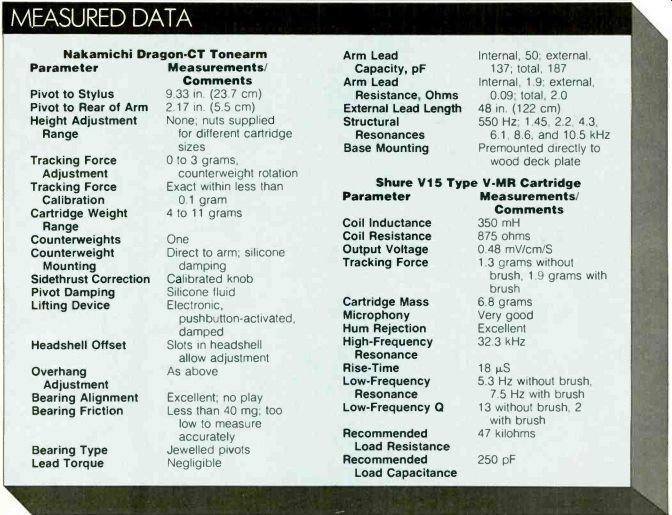
Figures 6 and 7 show the interchannel phase, the best I have ever seen for any tonearm/cartridge combination. The comments made by the listening panel regarding localization were really enlightening when considered with the inter-channel phase performance indicated by these figures. The system used in listening tests includes two very coherent, phase-matched, Time Align reference loudspeaker systems which I designed especially for such tests. When listening to the Nakamichi tonearm/Shure cartridge combination with this system, panel members could clearly hear the difference between spaced-microphone and coincident-microphone recordings--a difference not even the reference tonearm/cartridge system revealed so distinctly. When coincident recordings were played, anyone sitting on the center line between the loudspeakers had only to move his head very slightly to shift centered images to the left or right. Such is the price for perfectly matched channels in a stereo system! The tonal quality of voice was also changed by moving the head toward one channel or the other. This is due to the fact that, when the channel-to-ear time delay is changed, the frequencies for which addition and cancellation occur are also changed, yielding a perceived change in tonal quality or timbre.
When some really high-level recordings were played during the listening sessions, the Nakamichi/Shure combination was judged slightly better than the reference system in reproducing trumpet and cymbals. This is probably related to its remarkable tracking capability. Figures 8 and 9 show the output versus time and the spectrum due to tracking the highest level 1-kHz band of the B & K 2010 test record, which is cut at a level of 25 cm/S. This is the best result for any combination I have tested so far. The spectral distribution gives clues to how the sound will be perceived when tracking such high levels. The right channel tracks pretty well and shows a smooth distribution of harmonics, while the left channel exhibits some mistracking and favors the third, fourth, fifth, eighth, ninth and tenth harmonics. This could be perceived as a shift in timbre balance, although none of the panel members mentioned anything which could be linked to this. That doesn't mean it wasn't happening, however.
To be fair to the Nakamichi/Shure combination and to allow comparisons with other combinations evaluated in previous reports, I also tracked the next lower band of the B & K 2010 record a 1-kHz tone at 20 cm/S. This is the band which some fine cartridges just manage to track; the performance of the Nakamichi/Shure combination is shown in Fig. 10. Some indication of the spectral imbalance is still apparent at this level, but the third-harmonic distortion in each channel is below 1%, which is remarkable.
Shure's TTR-103 test record was used to make the 10.8-kHz tone-burst tests shown in Figs. 11 and 12. Even the 30cm/S level results in distortion well below 1%. In Fig. 12, I have shown these numbers in dB below the reference level rather than percentages because I believe it is easier to think in terms of sound levels expressed in dB when relating such levels to perceived effects.
Figure 13 shows the square-wave output of the Nakamichi/Shure combination and indicates a slight difference between the channels in the middle register. This confirms the data regarding spectral-level differences shown in the previous figures. The dip in the right-channel output's waveform also correlates well with the curves shown in Fig. 1, because the right channel does show a sharper cutoff at the high-frequency limit.
Conclusions
The Nakamichi Dragon-CT tonearm and Shure V15 Type V-MR cartridge proved to be a really compatible combination and produced excellent sound reproduction, indicating that the tonearm is well suited to high-quality, moderate-impedance cartridges. As I stated earlier, I learned a great deal about the interaction of tonearm/cartridge matching while evaluating this combination. If you have read the report without jumping right to this part, I hope that you have also. But I must add that I really feel sorry for those hardworking engineers at Shure. How are they going to top the V15 Type V-MR? If they can, we will all hear something truly fantastic!
-Edward M. Long
(Source: Audio magazine, Apr. 1985)
Also see:
Nakamichi Dragon-CT Turntable (Equip. Profile, Apr. 1985)
Nakamichi Dragon-CT turntable (advertisement, Jan. 1984)
Nakamichi Dragon Cassette Deck (May 1983)
= = = =